Veria: A Trove of Historical and Natural Treasures...
With its lush riverbanks, fine museums,...
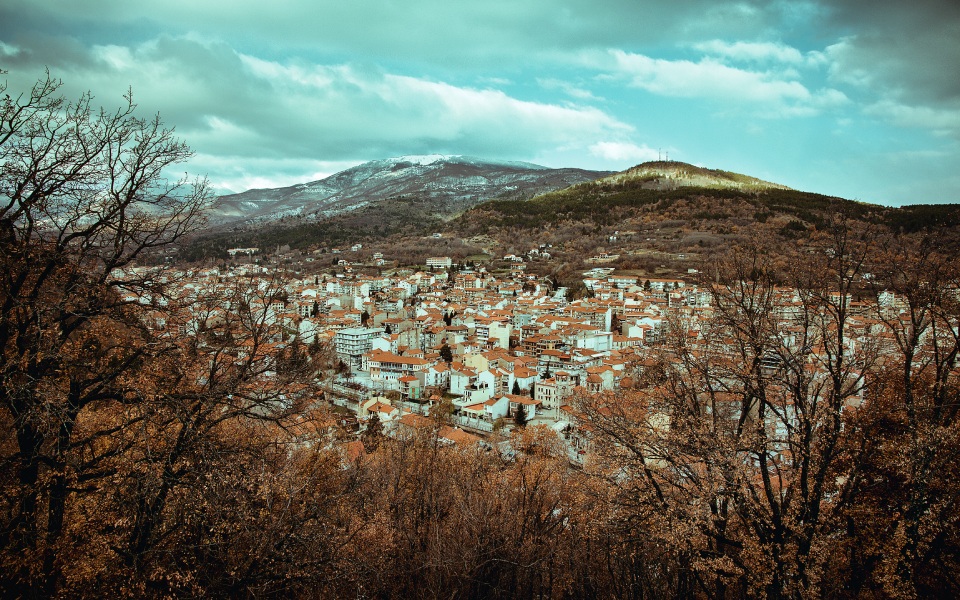
The view over Florina from the hill of Agios Panteleimon.
© Olga Deikou
In the photo I’m looking at, I can see an army unit, some teachers with their schoolchildren, various town’s associations with banners aloft, local dignitaries and military leaders, and a crowd of people behind them. The picture was taken on May 15, 1931, as the first train arrived in Florina from Bitola, in what was once Yugoslavia and is now North Macedonia. After stopping for a few minutes, the train continued on to Thessaloniki. Florina, a border town which had only become part of modern Greece 19 years earlier, was now connected by rail to the northern Greek metropolis and, by extension, to the world.
Today, more than 90 years later, the train’s arrival is hardly noticed. The station seems a forlorn place, and it is only when the trains arrive, three times a day, that you see people on the platforms. Florina is no longer connected with Bitola – this is the end of the line.
The train journey from Thessaloniki is approximately two and a half hours long, about as long as it takes to drive. The Egnatia Highway may have brought the cities of northern Macedonia closer, but the road itself has little charm. The cheap train fares make the railway an attractive option for students attending university in Florina, and for those who just love to travel by rail. On the route, you pass near Lake Vegoritida and through Amyntaio, Edessa, Naoussa and Veroia before arriving in Thessaloniki. The landscape you see out the carriage window is ever-changing, pushing thoughts of your destination to the back of your mind as you enjoy your journey. The mountain peaks covered in snow and the fog covering the plains are elements of an essentially Balkan scene, images reminiscent of those captured in the films of Theo Angelopoulos.
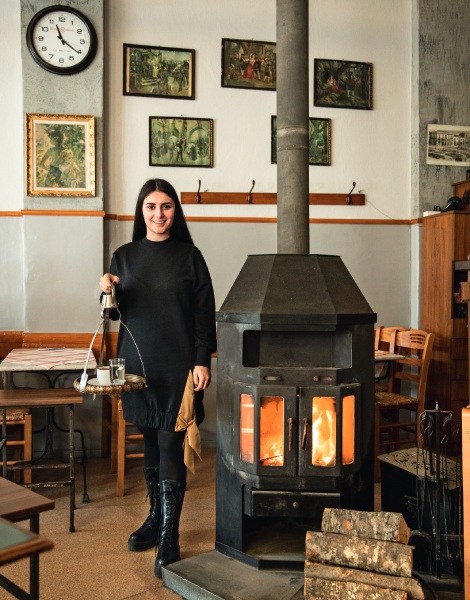
At the Diethnes Café, the fire in the stove is always burning.
© Olga Deikou
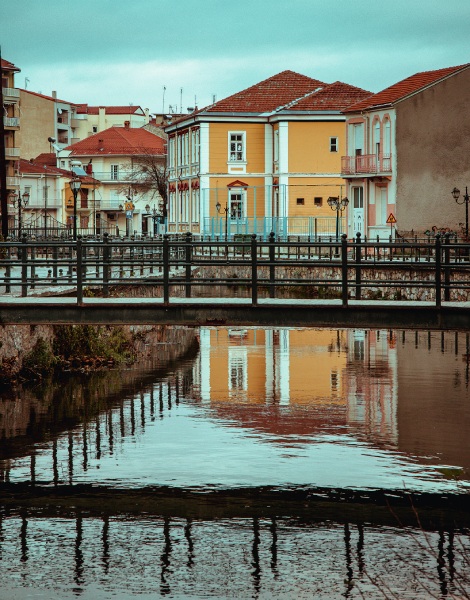
The Sakoulevas River runs through the town.
© Olga Deikou
That the area might remind you of Angelopoulos is understandable. The director picked Florina as the location for seven of his films, among them “The Beekeeper” and “The Suspended Step of the Stork”. He was drawn precisely by the melancholic landscape which surrounds the town and by its geographic location, which together made it an ideal setting for contemplating history, politics, borders and relations between neighboring states.
Standing in front of the cathedral on the banks of the Sakoulevas River, which runs through the town, I’m on the very same spot where demonstrators, stirred up by Bishop Augoustinos Kantiotis, tried to stop the filming of “The Suspended Step of the Stork” in December of 1991. Having decided that the film was pornographic and treasonous, Kantiotis first threatened all local residents who took part as extras with ex-communication, and then, after more days of protests, actually did excommunicate everyone involved with the film. Because of the protests, some scenes were filmed without sound, the shouts of the angry crowd being too loud, while the presence of the film’s two international stars, Marcello Mastroianni and Jean Moreau, ensured that the fuss made news bulletins around the world.
In a number of his films, Angelopoulos featured exterior shots of his beloved café Diethnes. The café has remains unchanged through the years, with the exception of the flat screen TV which now hangs on the interior wall above the door lintel. The wood-fired stove burns constantly, and tispouro with meze is served from the early afternoon, as visitors try to capture the authentic atmosphere on the cameras of their mobile phones.
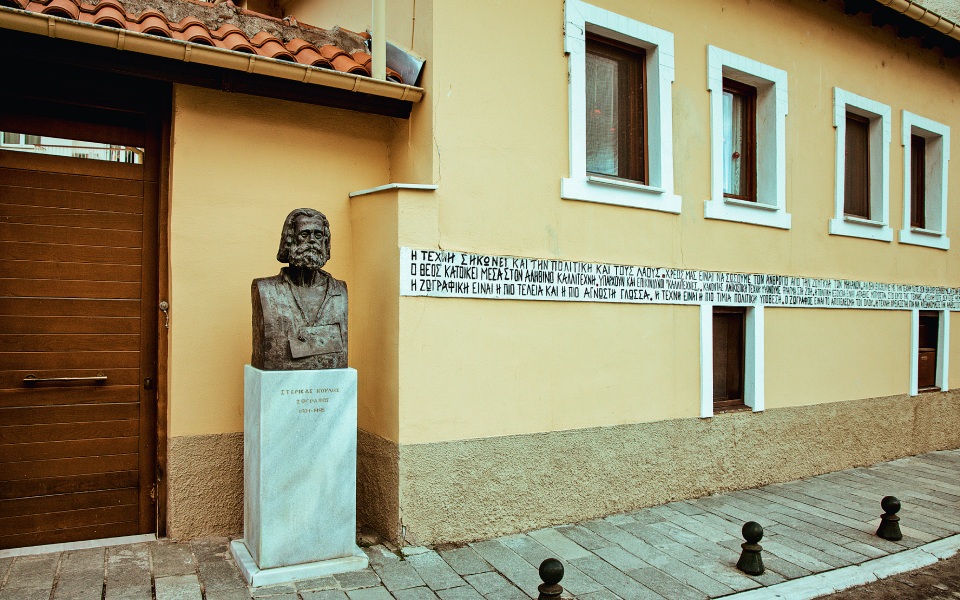
The house of the artist Sterikas Koulis.
© Olga Deikou
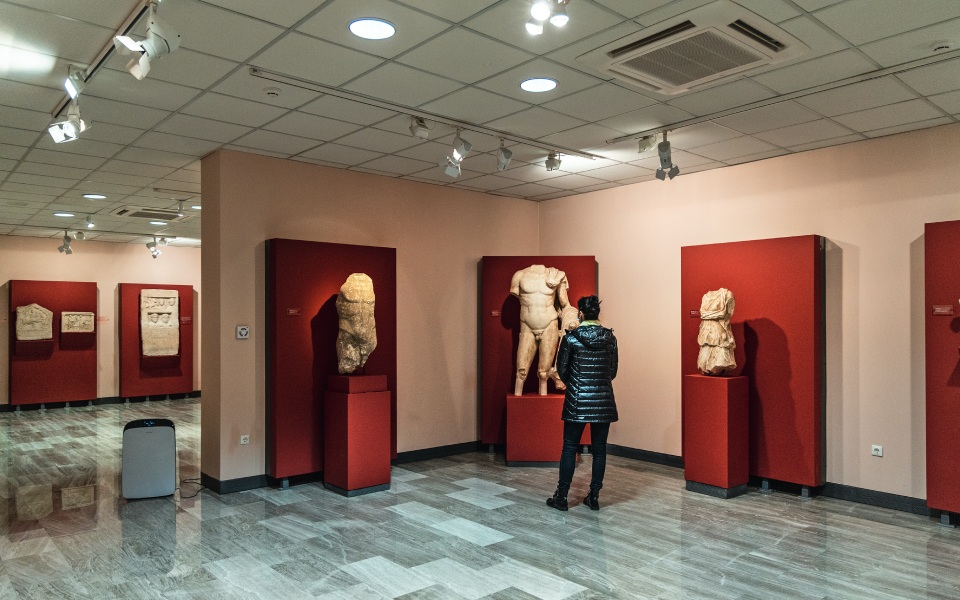
The Florina Archaeological Museum.
© Olga Deikou
Angelopoulos is not the only artist to have been bewitched by Florina. In 1936, the poet George Seferis described his journey to Koruca, where he had been appointed Consul, in a letter to his girlfriend: “Then, towards the end, when the mountains appeared with their peaks hidden in the clouds, I was seized by a desire to shout or turn somersaults from boredom. At Florina fortunately […] the light had lowered significantly. I have rarely seen such beauty. A landscape which had your color from end to end. Mountains to the right and left. We advanced through a gorge. On both sides the slopes were covered in beeches in the color of smoke, darker and darker. Occasionally, bigger trees stood out, like leaders.”
Florina, built in a gorge and with a river bisecting it, seems to inspire creativity and provoke artistic expression. There is no other way to explain the connection its residents have to the creative arts. Many locals paint, professionally or for pleasure, while an artists’ workshop rose up around Florina’s Aristotle Association for the Promotion of Education in 1941. The town is also home to the Contemporary Art Museum and Florini Artists’ Gallery, which hosts many exhibitions, including shows by graduates of the local Fine Arts School, which has been based here since 2006.
What can account for such a vigorous art scene, and what makes locals pack the art studios? “Our scenery lacks color, so we wanted to add it to our lives,” says Anna, who was born and raised in Florina. The difficult conditions which followed the Greek Civil War in the late 1940s also played a part, with the need to find some respite from the strict conservative environment of the border town. Certain individuals also played a significant role, such as Dimitris Linaras, one of the first major local painters, or Sterikas Koulis and Kostakis Loutsas, who were both inspired by Florina and created some of their best-known works in the town. Remote, close to the border, and bitterly cold eight months out of the year, Florina does not favor outdoor activities. Local choose pastimes which can be undertaken indoors – which also probably accounts for the popularity of fencing in the town. Many national champions started their careers here, while dozens of children practice daily in the local facilities.
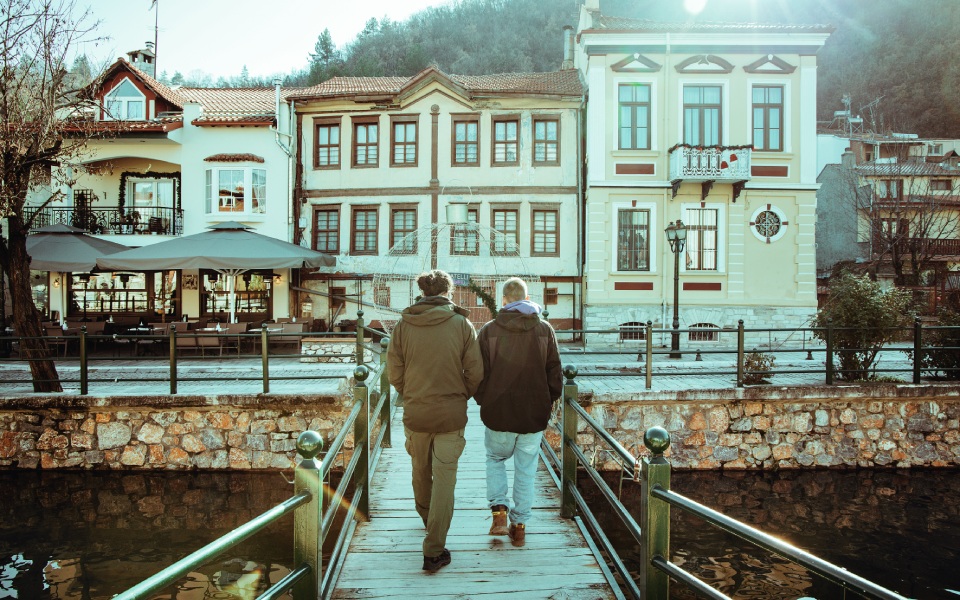
Locals often take a stroll down by the river.
© Olga Deikou
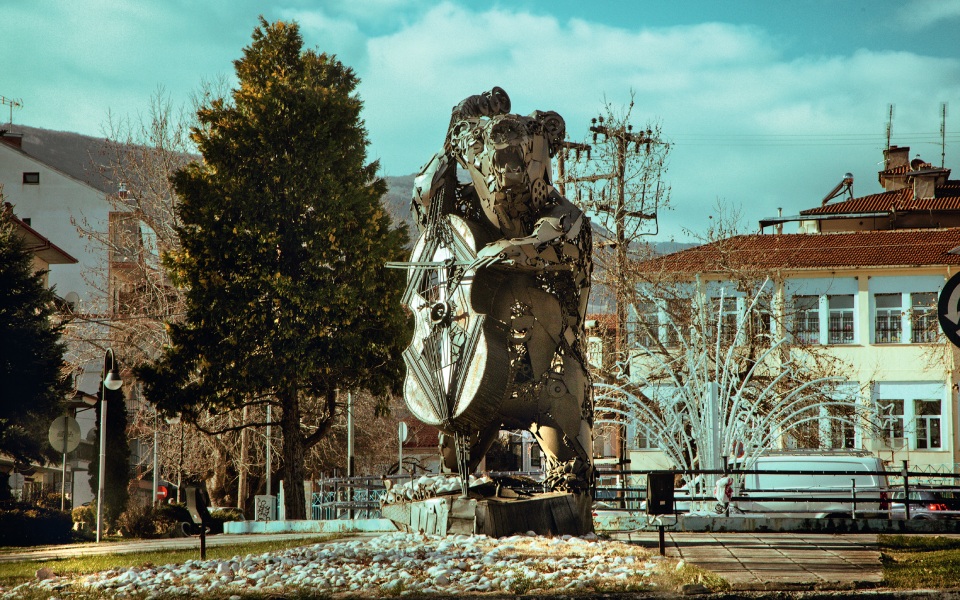
“Contralto" is a work by sculptor Giorgos Bardakas.
© Olga Deikou
As you might expect, the weather and the temperature are popular topics of conversation in Florina. This year, the first snow fell in December, but local are used to extreme weather. Every year in November they switch to snow tires, which they don’t take off until spring. Woodpiles are a common sight outside homes, and the smell of woodsmoke dominates the town’s streets. Even when the sun shines, the cold is bitter, particularly on the busy main road which runs alongside the river. You can easily tell the visitors, in their gloves, wooly hats and scarves, from the locals, who favor light jackets. Locals will tell you about the “punch” they drink on cold winter mornings (made from tsipouro and a little honey or sugar), and about the year when the temperature stayed at -15 C for an entire month, or the time when the roads were impassable without 4-wheel drive and pedestrians had to go uphill on all fours. The road leading to the ski center of Vigla-Pisoderiou, 10 kilometers from Florina, glitters with salt which is spread in the winter awaiting the thick snowfall.
On my visit, the surrounding mountains are already cloaked in snow, while the lower slopes are green with hardy oaks and fir trees. Everyone’s cheeks are rosy from the cold air, the blue waters of the river foam as they reach the waterfall, musicians play shiny brass instruments in the sunshine; all the colors that a painter would need to create a masterpiece are here.
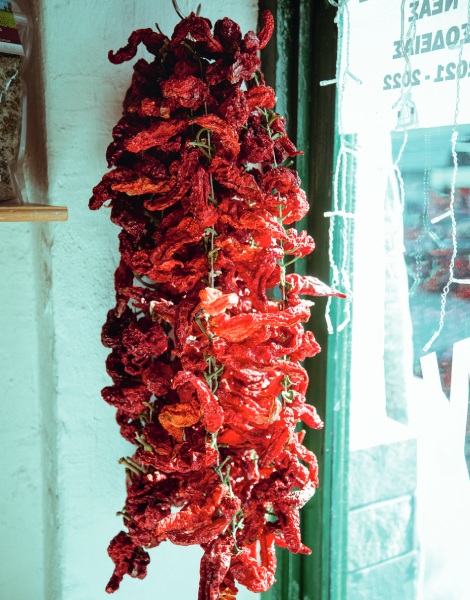
Florina peppers
© Olga Deikou
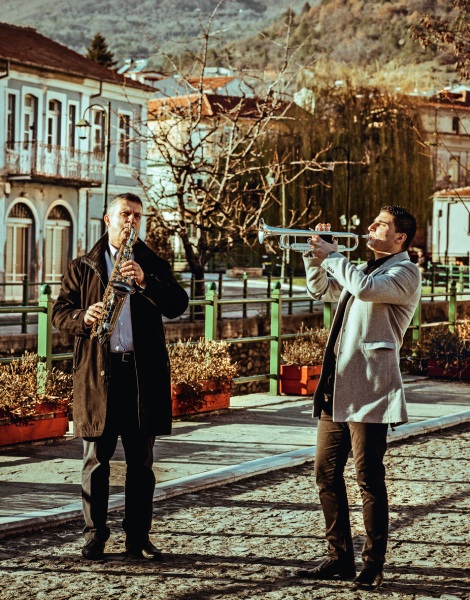
Lazaros Valkanis with his son Tassos, both members of the Valkanis Brothers Brass Band.
© Olga Deikou
Thanks to the tireless care of printer Grigoris Alexiou, the Traditional Printing Press operates regularly in a room provided by the teaching academy of the University of West Macedonia. Students and visitors can, by arrangement, view all the stages in traditional printing, from typesetting and inking through to printing on the large, fully operational vintage printing presses, learn about the art of printing and print their own page as a souvenir. (Tel. (+30) 23850.550.38.)
Archaeological finds from the area are housed in the Florina Archaeological Museum (8 Sidirodromikou Stathmou, Florina, Tel. (+30) 23850.282.06, open daily except Tuesday, 07:30-15:30, entry €5). On display you’ll find ceramics and tools from the prehistoric era, statuettes from nearby Hellenistic cities and an impressive Roman floor mosaic. There is also a collection of artifacts from the Prespes area, dating from the Middle Byzantine period to the 18th century.
The Valkanis Brothers Brass Band is synonymous with the rich musical tradition of the area, with some members now being the fourth generation of their family to play in the ensemble. Traditional and Balkan elements as well as the distinctive soundscape of brass instruments, and all combined with more contemporary approaches and settings, are part of their regular set and feature on their latest album, “Melodias Radiostagma”. Information, video and concert dates can be found on their Facebook page: Valkanis Brothers Brass Band.
There is a farmers’ market every Wednesday in the Municipal Market, offering an excellent opportunity to pick up Prespes beans, Florina peppers, local honey and other local produce.
The art work “Contralto” stands at the entrance to the town; the sculpture of the bear is by local artist Giorgos Bardakas, created while he was studying at the Department of Fine and Applied Arts at the University of Western Macedonia in Florina.
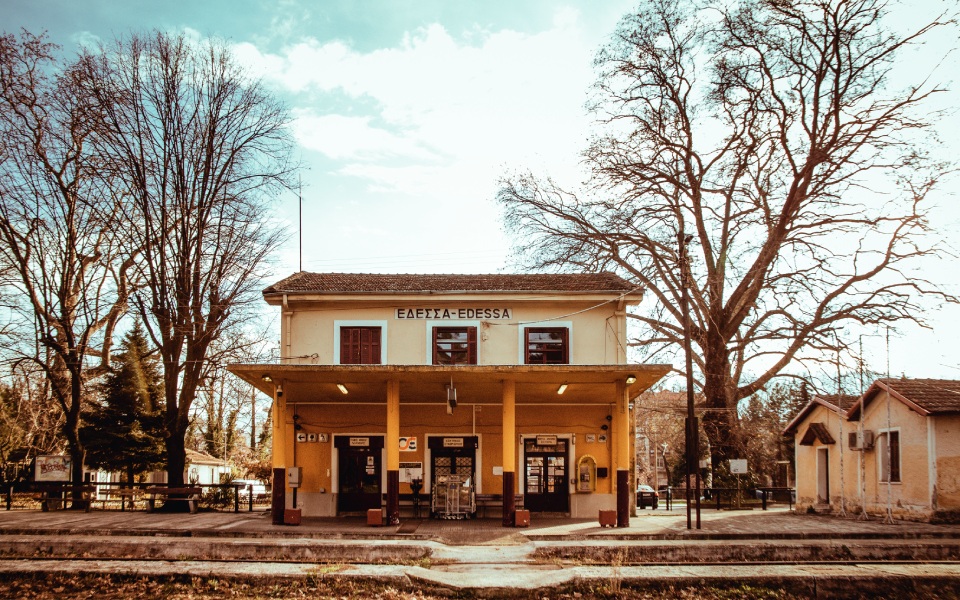
The Edessa railway station connects the town to Thessaloniki, Florina, Naoussa and Veroia.
© Olga Deikou
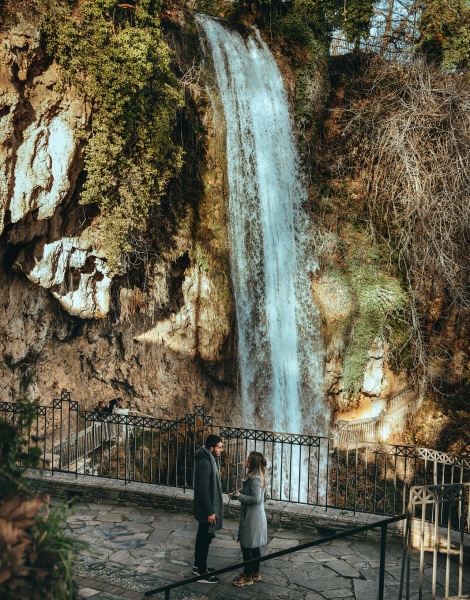
The famous waterfall is 70 meters high.
© Olga Deikou
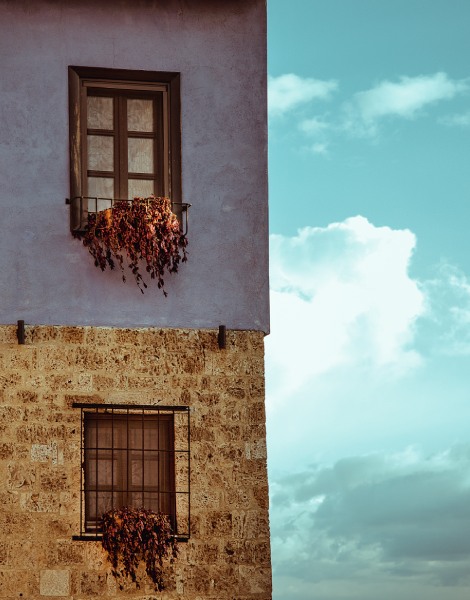
Varosi, a traditional village in the Edessa region.
© Olga Deikou
From Thessaloniki, it takes an hour and a half to reach Edessa by train, and then not quite as long again for Florina. Edessa is perfect for a short stop along the way. You can admire the town’s landmark 70-meter waterfall or stroll through the town park, where there’s a small cave and a café. A side trip to Varosi, a village with well-preserved 19th-century mansions built in the traditional Macedonian style, will prove rewarding. You can enjoy a meal at the taverna “Opos Palia-Tziggas” (25 Martiou & Konstantinopoleos, Tel. (+30) 23810.214.44) which specializes in grilled meats, plentiful salads and an extensive range of Greek bottled wines. Departing Thessaloniki on the 13:21 train, you’ll be in Edessa by 15:00, and after a leisurely late afternoon in what Greeks call “the city of waters,” you can catch the 20:40 to Florina.
GETTING THERE
Florina is located 451 km from Athens and 169 km from Thessaloniki. There are five daily train services connecting Athens to Thessaloniki, and the journey time is 4 hours 23 minutes. A one-way ticket is €40.80 and a return with a 20% discount is €65.40. On the Thessaloniki-Florina line, there are three trains a day and the journey time is 2 hours 30 minutes, with stops at Platy, Edessa, Arnissa, and several local stations. The ticket costs €10 one way, and €16 for a return.
ACCOMMODATION
The Lynx Mountain Resort (Lofos Agios Panteleimona, Florina, Tel. (+30) 23854.409.00, thelynxresort.gr). On the site of the old Xenia hotel, you won’t find a better view in town. Rooms and suites are spacious, modern and include all amenities. Breakfast includes omelets made to order, while the restaurant offers a range of dishes for all hours of the day. Benefits include a gym and spa. From €114 for a double with breakfast.
Emerald Suites (47 Konstantinou Karamanli, Florina, Tel. (+30) 23850.227.77). Elegant, bright and well-equipped rooms and suites in a quiet location a little outside the town center. From €75 for a double with breakfast.
Phaidon Hotel & Spa (1 Viglas and Varnountos, Florina, Tel. (+30) 23850.448.00). A classic hotel with comfortable, tasteful rooms in a neoclassical style, spa and rich breakfast selection. From €67 for a double room with breakfast.
Lingos Hotel (1 Tagmatarchi Naoum, Florina, Tel. (+30) 23850.283.22). Offers a central location and attractive prices. From €55 for a double room with breakfast.
FOOD
Aposperitis (6-8 25th Martiou, Florina, Tel. (+30) 23853.007.94). Here you can try one of the best versions of the local specialty, kebabia. These are small meatballs served with onions and red pepper flakes. Try the bouyourdi, a Florina pepper stuffed with cheese, and makalo, meatballs with a broth and flour sauce, another local dish.
Terpsi (5th kilometer, Florina-Kato Kleina Secondary Road, Tel. (+30) 23850.940.40, open from 17.00). Superb dry-aged meat from western Macedonian farms are served at this restaurant five kilometres north of Florina. Try specialty cuts, like the chuck-eye steak or the hanger steak, or oxtail with hilopites (noodles), or ribs with barbecue sauce.
Koukoutsi (6 Stoa Spyraki, Florina, Tel. (+30) 23850.460.10). Informal atmosphere and meze of all types. We tried the fried eggs with soutzouki and smoked pork belly, the barbecued ribs and the veal filet. Great selection of bottled tsipouro.
Boukovo kai Meli (Plateia Omonoias, Florina, Tel. (+30) 23850.223.88). Grab one of their tables on the town’s central square and enjoy the sophisticated meze, which includes smoked cheese croquettes; miniature pies with pastourma (cured meat), kasseri cheese and tomato; and ribs with mustard and thyme sauce.
Klossa (3 Stratonon, Florina, Tel. (+30) 23850.238.61, open from 20.00, and serving lunch only on Sunday). Locals will tell you this place serves the best kebab and they aren’t wrong. Try the expertly grilled steaks, juicy ribs and spicy sausages as well.
COFFEE – DRINKS
Diethnes Café (96 Megalou Alexandrou, Florina, Tel. (+30) 23850.235.85). An authentic traditional café away from the center, famous for featuring in several Angelopoulos films. Sit by the wood stove for a Greek coffee or tsipouro accompanied by tasty meze.
Florian (60 Eleftherias, Florina, Tel. (+30) 23850.265.22). Facing the river, this two-story building has country-style decor with floral elements well-suited to its extensive selection of teas and hot chocolate.
The Factory (5 Spyraki, Florina, Tel. (+30) 23850.296.64). A favorite central meeting place for coffee or drinks. It serves quality cappuccino, well-made cocktails and also has a loft for greater privacy.
Aerino Winebar (Plateia Marathonos, Florina, Tel. (+30) 23850.448.97). A beautiful, lively space for wine lovers. You’ll find dozens of Greek wines, many of which are available by the glass. The venue often hosts themed tasting evenings. The accompanying dishes are refined, and there’s also a cellar for private parties.
En Florini (16 Tagmatarchou Fouledaki, Florina, Tel. (+30) 23850.229.11, open from 19.00). Jazz, blues, and ’70s tunes feature on the playlist of this attractive bar on the second floor of a downtown building. Try their warm cocktails, or their raki or wine with honey.
Lygistis FOOF (Lofos Agios Panteleimona, Florina, Tel. (+30) 23850.298.12). The odd name is derived from the ancient name for Florina, while the acronym FOOF refers to the local mountaineering club that built this café venue high on a hill overlooking the town. The view is stunning.
With its lush riverbanks, fine museums,...
From the salt-sprayed islands to the...
A visit to the thermal waters...
Where conservation meets tradition, a village...